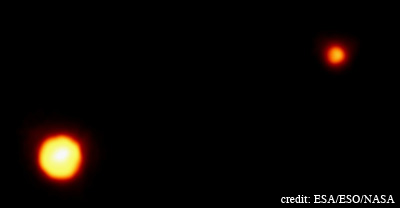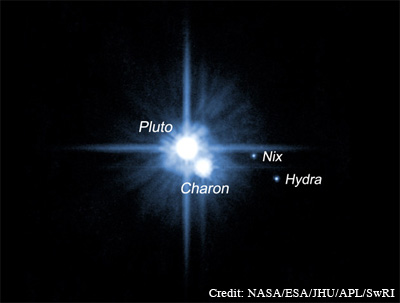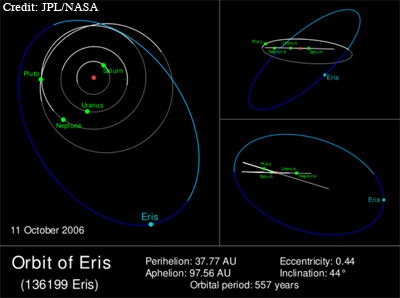
Dwarf PlanetsDwarf Planets
SUMMARY: Major discoveries in the past decade have forced astronomers to review the definition of a planet. Our solar system now has three classified dwarf planets: our beloved Pluto, Eris, and Ceres.
What Defines a Planet?
Pluto
Pluto's Moons
Eris
Ceres
Related Links
Related Lessons:
Modeling the Orbits of Planets
Phases of Charon
What Defines a Planet?
The definition of a planet was revised again in 2006. According to NASA, the International Astronomical Union (IAU) most recently defines a planet as a celestial body that:
- Is in orbit around a star, but is not itself a satellite*
- Has sufficient mass so it is nearly spherical in shape*
- Has cleared the neighborhood around its orbit*
On the other hand, a dwarf planet is defined as a celetial body that:
- Is in orbit around a star, but is not itself a satellite*
- Has sufficient mass so it is nearly spherical in shape*
- Has not cleared the neighborhood around its orbit*
The only difference between a planet and a dwarf planet is the area surrounding each celestial body. A dwarf planet has not cleared the area around its orbit, while a planet has. Since the new definition, three objects in our solar system have been classified as dwarf planets: Pluto, Ceres and Eris.
*Text courtesy of NASA
Pluto
For 76 years (until 2006), Pluto was known as the ninth planet in our solar system. Since then, Pluto has been relegated to dwarf planet status. Discovered in 1930, Pluto is a member of the outer region of our solar system known as the Kuiper belt. It has a highly inclined and eccentric 248-year orbit around the Sun. As the second-largest known dwarf planet, Pluto is approximately 2,390 km in diameter and is composed primarily of ice and rock. It is very difficult to precisely determine the diameter of Pluto since it is so far away. Pluto is, on average, 40 times farther from the Sun than Earth.
The New Horizons spacecraft, scheduled to arrive at Pluto in 2015, will be able to provide us with more accurate measurements of Pluto. Pluto's surface is made almost entirely of nitrogen ice, with traces of methane and carbon monoxide. Data from Hubble Space Telescope leads scientists to believe Pluto's interior is about 60% rock and 40% ice, which is consistent with the composition of a comet. Pluto has a thin atmosphere made of the same components of its surface: nitrogen, methane and carbon monoxide. Like a comet, Pluto's atmosphere freezes as it moves away from the Sun and the ices sublimate as it approaches the Sun.
Pluto's Moons
In 1978, the discovery of Pluto's largest moon, Charon, gave scientists an opportunity to learn more about Pluto. The two icy objects eclipsed each other from Earth's point of view from 1985-1990 allowing scientists to more precisely determine their diameters and masses. At approximately 1,186 km, Charon's diameter is just less than half of Pluto's. Pluto is also eight times more massive than Charon.
It is not uncommon for a moon to be locked synchronously with its planet, just as Earth's moon is locked to Earth. It is far less common, however, for a planet to be locked synchronously with its moon. The Pluto-Charon system is the only planet-moon system in our solar system locked synchronously together, with each always showing the same face to the other.
Two more moons were discovered orbiting Pluto in 2005. Nix and Hydra are considerably smaller than Pluto and Charon, at only 40 km and 160 km in diameter, respectively. Nix orbits Pluto at 48,700 km from the center of mass of the system, more than twice the orbital distance of Charon. Hydra is the outermost of Pluto's satellites, orbiting at 64,800 km from the center of mass of the Plutonian system.
Eris
Discovered in 2005, Eris is now the largest known dwarf planet in our solar system. Its diameter is estimated at 3000 km, and it weighs roughly 1.66 x 1022 kg, which is about 27% more massive than Pluto. Like Pluto, it is very difficult to make precise measurements of Eris' diameter and mass, but these are the most updated estimates.
Eris orbits the Sun at the far reaches of our solar system in an area known as the scattered disk. Scattered disk objects (SDOs) tend to have highly inclined and eccentric orbits. Eris' orbit is tilted at an angle of 44 degrees with respect to the ecliptic. You can see from the picture how much more inclined this is compared to Pluto's orbit, which is tilted only 17 degrees to the ecliptic. Eris' orbital period is just over 556 years. Currently, at a distance of about 97 AU, Eris is at aphelion. It won't be closest to the Sun, at perihelion, until March 2257.
Eris has one known moon, Dysnomia, named for the mythological daughter of Eris. Dysnomia's diameter is estimated to be less than 150 km. It takes only 15 days for Dysnomia to orbit Eris at a distance of about 37,370 km. It is thought that Dysnomia formed around Eris in a similar way our Moon formed around Earth. This theory states that Earth was involved in a major collision with an object over 1000 km across that ejected a lot of material from the surface of Earth. This material eventually combined to form our Moon.
Ceres
Italian astronomer Giuseppe Piazzi discovered Ceres in 1801. First classified as a planet, Ceres was later catalogued as an asteroid. With the discovery of Eris in 2005, after 150 years as the head of the asteroid belt, Ceres became the solar system's smallest dwarf planet. Ceres is still the largest, and by far the most massive member of the asteroid belt. The diameter of Ceres is about 950 km and it alone makes up one third of the asteroid belt's total mass.
Launched in the summer of 2007, NASA's Dawn spacecraft is headed for two of the asteroid belt's largest objects. Dawn is scheduled to arrive at the asteroid Vesta in 2011, and collect data during a series of orbits. After four years of interplanetary travel, Dawn will arrive at Ceres to collect more information on the newly designated dwarf planet.
New Horizons website on Pluto science
Minor Bodies Website
Animations of the motion of objects in the solar system
Mike Brown's page on dwarf planets
Dave Jewitt's KBO page
New Horizons
Dawn






